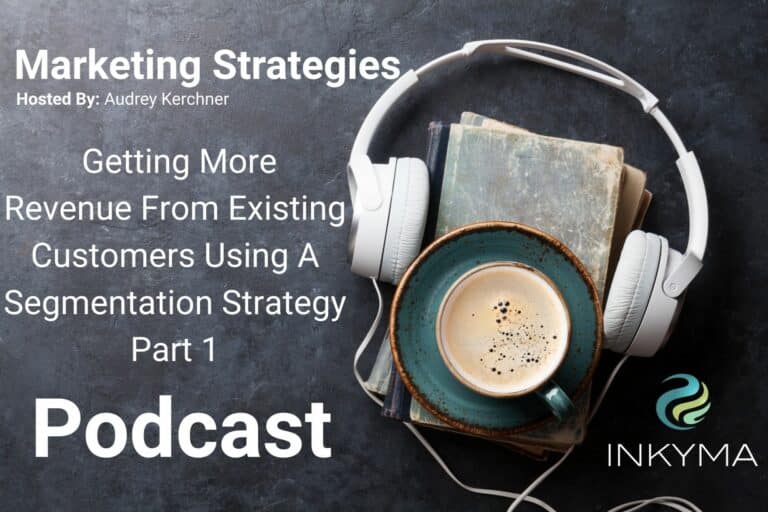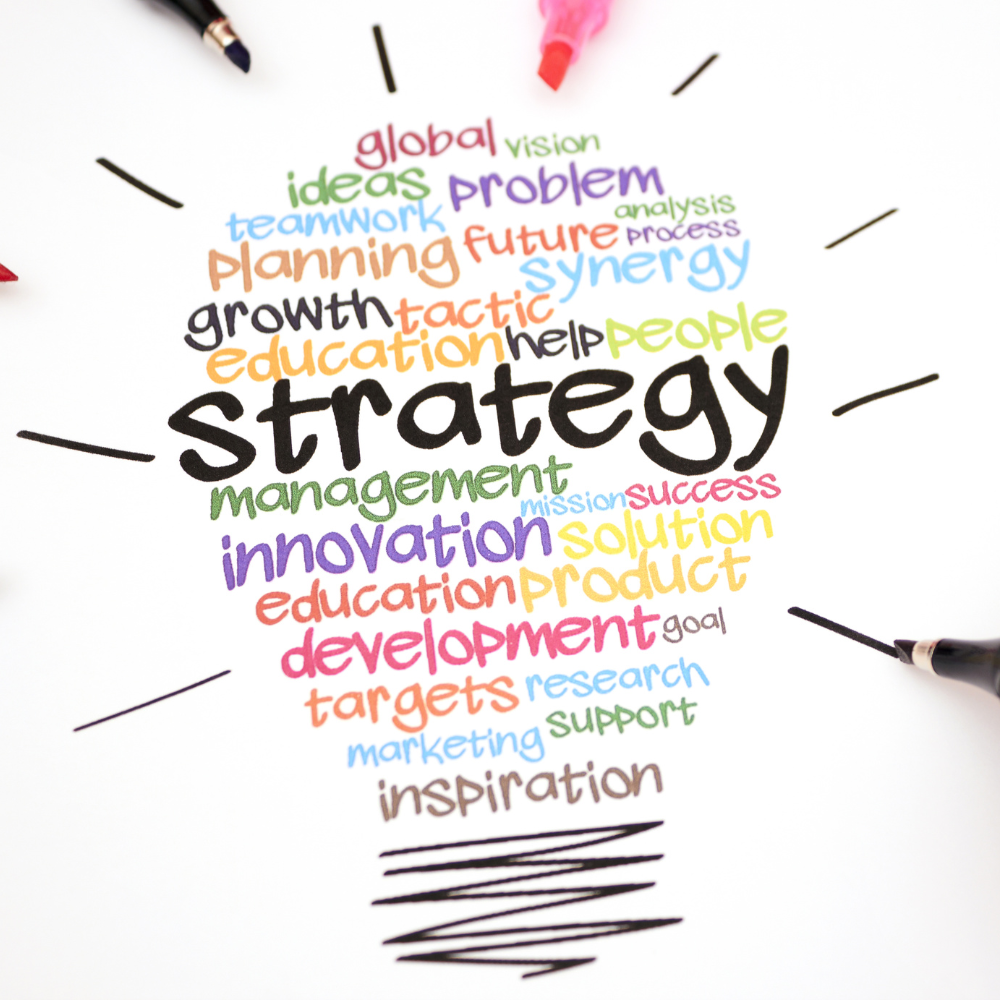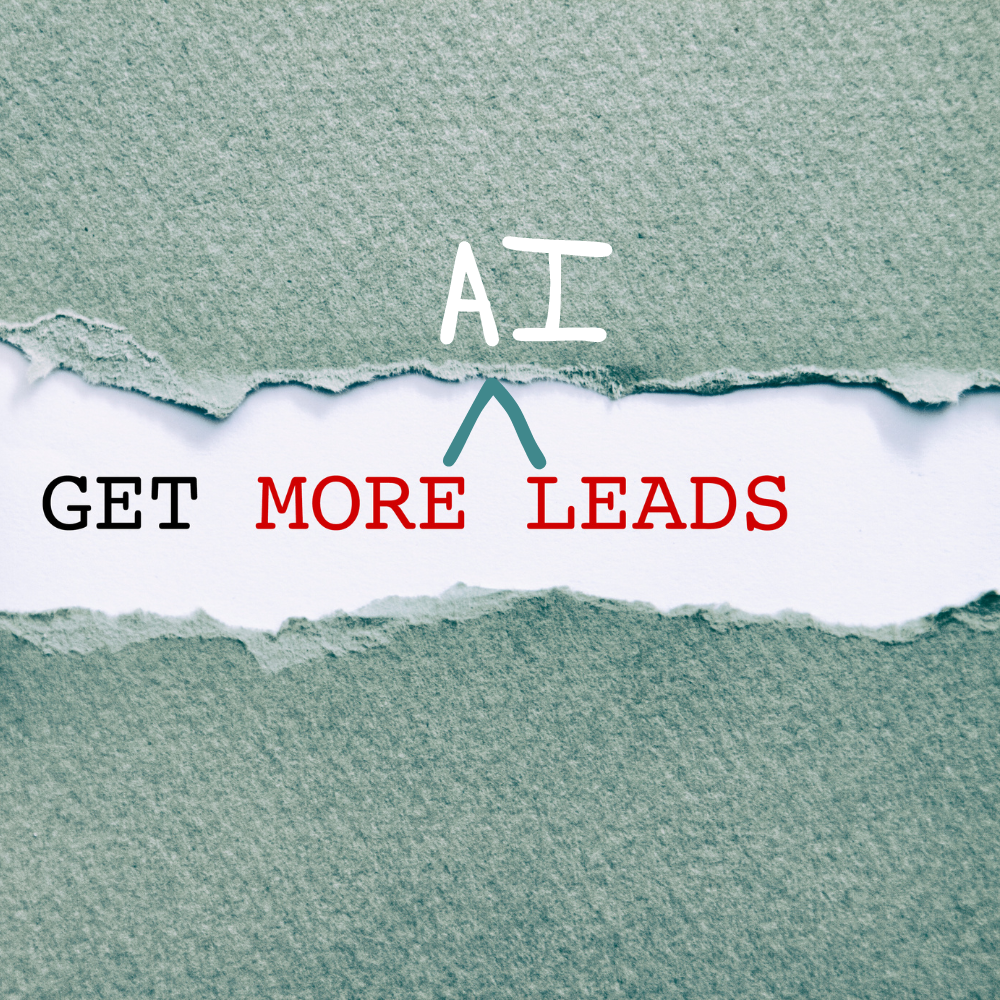On this two-part episode of Inkyma’s Marketing Strategies, Audrey focuses on creating revenue from existing customers using a segmentation strategy by creating a tier identification and selling structure of your existing customers. By keeping your classifications simple and easy to remember, High, Medium, Low value customers, you don’t have to overcomplicate this!
Links Mentioned In This Episode:
Link for increased spend existing customers
Getting More Revenue From Existing Customers Using A Segmentation Strategy Transcription
Audrey Kerchner:
Focusing on existing customers can increase your profits anywhere from 25 to 95%.
Announcer:
Welcome to Marketing Strategies with Audrey Kerchner sponsored by Inkyma, taking your small business to the next level with proven creative solutions designed to grow your awareness and connect to your customers. Now here’s Audrey.
Audrey Kerchner:
In the last episode, I talked about customer retention, referral programs for customers, and selling strategies for your existing customers. In the next two episodes, this is going to be a two-parter. This is part one. I’m going to break down really great strategies for increasing revenue with your current customers. So how do we do this? At a basic level, just to kind of intrigue you just a bit, we create tier identification, segmentations, and then selling structures for those segmentations to your existing customers. So an example would be a high, medium, low-value customer segmentation strategy that you create campaigns to move people from the low-value customer to the medium, to the high, and then to retain the high-value customers. And that is what we’re going to talk about in this episode and the next episode. This is Audrey Kerchner and I am the co-founder and chief marketing strategist here at Inkyma.
Audrey Kerchner:
Inkyma is a full-service marketing agency, and we bring that big agency feel, and process, and service level to small business owners. To learn more about what we do, ask a question, or to schedule a marketing evaluation, go to our website, inkyma.com. That’s I-N-K-Y-M-A.com. If you’re a new or returning listener. Welcome! We’re so glad that you’re here. If you’re enjoying this podcast, please follow us. Pick whichever your favorite podcast platform is, and we are definitely on it. Just look for Inkyma and you will find Marketing Strategies. Also, all of the episodes are on our website with transcripts, as well as our YouTube channel, so why focus on segmenting and trying to sell more to your existing customer? Let’s talk about why it’s important to focus on selling more to your existing customers. And I’m going to start out with a statistic because that’s usually really where I grab folks.
Audrey Kerchner:
Existing customers are 50% more likely to try a new product or a new service, new to them, not new to you. And they’ll spend about 31% more than compared to a new customer, so think about that. You’ve got an existing customer and you make them aware of a different product or service. Not only are they going to buy it, but they’re actually going to spend more than a brand new customer with that same level of awareness. The other great thing about this is– And if you listened to episode 29, I talk about when you’re marketing to your existing customers, it costs you far less to get them to take action, to buy more than it is to acquire a brand new customer. So not only are you spending less money to get your existing customer to buy from you, but they’re also buying more. So the return on investment is far greater than when you bring in brand new customers.
Audrey Kerchner:
The next thing is when you take on a strategy like this, nine times out of 10, your competitors probably aren’t and that’s just based on statistics. When you take a look at the link in the show notes for this great infographic that I found. Only 18% of businesses are focused on their current customers. Most of them are out there spending all their money on getting brand new customers and new leads for their business. Let’s talk about a scenario where you’re not selling to your existing customers and neither is your competitor, right? Maybe that’s your situation right now. So I want to give you an example, let’s take an accountant and he or she, they do tax prep, right? Everybody knows most accountants do tax prep, that’s what we all hire them for. But then you, as an accountant, you also do bookkeeping.
Audrey Kerchner:
And then you also do quarterly tax reviews for businesses and for private people that have really complicated taxes, maybe they own multiple properties, maybe they own two or three businesses, their kids, all that other good stuff. In this example, you talk to someone and they become your client because you do their taxes in April. That’s great, right? You got that revenue, they’re a client, they’re really, really happy with you, but you’re not doing any type of promotion or awareness to existing customers about your bookkeeping services or about your quarterly tax review. Well, this particular customer feels like, Hey, I need to get a bookkeeper for my business, so not knowing that you do it, they actually go out and they search for bookkeeping and they find one of your competitors and they hire your competitor, so now you have you doing their taxes, once. They hire the bookkeeper, which there’s ongoing conversation there, and then that person just naturally falls into doing their taxes, so not only did you not upsell or get more money from an existing customer, but you actually lost them as a customer and they gained it. Now in the scenario where you are doing a great job of generating awareness and selling more to your existing customers and segmenting them out, so this customer you’ve segmented that you’ve done their taxes and you want to offer them bookkeeping services because you know they have a business, you do their taxes, you know that they have a business. So you reach out to them a month or so later, and you’re saying, Hey, we did your taxes. This is great. Let’s do quarterly tax prep. And let us do your bookkeeping for you. Let’s have a conversation about that.
Audrey Kerchner:
Company B is not doing any of that, so not only do they hire you for bookkeeping, you’re having quarterly conversations with them. They’re very excited and they’re happy with you. They start referring you to their business colleagues and those business colleagues happen to be clients of business B. Well, guess what? They don’t know that business B also does all the same things, so they switch over because they like the thought, and ease, and convenience of working with someone who’s going to do all of that stuff for them based on a referral. And so in these two scenarios, not only is it a win-win-win, but it’s also keeping you from losing existing customers as well. And so there’s another statistic that’s in that infographic and it’s focusing on existing customers can increase your profits by 25 to 95%. So if you look at the example that I just shared with you, you got the one customer and they got the taxes from you, and let’s say they took you on for quarterly tax review. Boom, that’s an increase in your revenue, then the bookkeeping, boom, that’s another increase in revenue. Now let’s talk about that third one. They referred you because they’re so happy with you. You asked for the referral, hopefully, you’re doing that within your campaigning and your communications. We’ll talk about that in part two. And they sent you three more customers, that is direct revenue that you can attribute to your existing customer. So the key here is not all the profits and generated revenue is going to come from that single customer. It’s also going to come from the people that they refer to you as well. And I talk about this in episode 29, but this is just a really good example of how you can just maximize talking to your existing customers.
Audrey Kerchner:
And so now let’s talk about what we’re going to focus on when you do have those conversations. Most likely your competitors are not focused on marketing to their existing customers. Only about 18% of businesses focus on talking to and marketing to their existing customers. They’re way more focused on lead generation and new customer acquisition than they are talking to existing customers. So if you do more of that than they do, you’re naturally going to be ahead of the game when it comes to growing your business. And if one of your goals for this year or next year to grow your business is a financial one. I want to increase my net growth by X number of dollars. Then paying more attention to your existing customers is definitely something that you want to take on because focusing on existing customers can increase your profits anywhere from 25 to 95%. With that, now you know that if you have growth objectives, which most small business owners do, let’s talk more about what to focus on with these existing customers. And to put it very succinctly and very plainly, you need to focus on awareness.
Audrey Kerchner:
You need to make your existing customers aware of all of the products and services that you sell. Now you may think, well, they are right? If they bought one thing from me, they’re certainly going to go back and see what else I have to offer. If they really, really like me. That’s not always the case. And it’s really because most of us as consumers, me included, we have tunnel vision. We’re very focused on that one thing that we need at that moment in time from a specific company, taking care of that, purchasing, getting the service, and then moving on to whatever’s next in our day. And not really looking at everything else, even if we were extremely happy, we may just not get back around to it.
Audrey Kerchner:
And so let me give you an example. Let’s use a cleaning company, a person finds and needs a cleaning company for a holiday party that they’re throwing. They want them to come and clean the house before. And hopefully, as part of the package, they’re also getting an after cleaning, right? Because the house is always a mess after the party as well, so they find the company, they get the services, they are extremely happy, they’re very satisfied, but what they don’t realize because there’s other stuff going on during that timeframe is that that cleaning company also provides weekly, biweekly, and monthly cleaning services for just day-to-day wear and tear on the house. The company also does spring and fall cleanings, like deep cleanings, which may include interior window cleaning or drape cleaning. They also do commercial cleaning for small business offices, and then they provide laundry services as well. So that one person that got that one-time cleaning may need one or all of these additional services, at some point throughout the rest of the year. Maybe they’re a business owner, they have an office, they have a retail location, and wouldn’t it be great if you could combine the home services and the business service under one company, but people can only take in so much information at one time, so in that example where the person was trying to find someone to clean the house before the party is they were doing other stuff to support the party, maybe cooking, catering, buying gifts, depending on what’s going on. Stuff’s happening with the family, kids are in school, the business, right? Something’s going on at the office that they have to take care of. So they don’t have time to consume the rest of the information at that moment in time. By creating a strategy after you fulfill those immediate needs to make them aware of other things that you can do for them, long-term they’re more likely to come back and buy more because they had that really wonderful experience with you the first time.
Audrey Kerchner:
So when they do need to have their office cleaning done and they see something from you like, “Oh, I didn’t realize they did that. Let me take on that service as well.” And this is why marketing to existing clients and talking to them often is a really great strategy to get that awareness.
Audrey Kerchner:
You’re listening to Marketing Strategies and I’m Audrey Kerchner. And we’re talking about leveraging your existing customers to grow your business. If you have a marketing question or a topic suggestion, you can submit it on our website inkyma.com, that’s I-N-K-Y-M-A.com and scroll down to the contact form that’s on any page, fill it out. , And I will absolutely get back to you on whatever the question is.
Audrey Kerchner:
You need to segment your existing clients so that you can talk to them in a personalized way. You want to try to not be generic at all the different levels, so now let’s talk about categorization or segmentation, if you will, strategies, because there are really, really so many different ways to segment your audience, but it all needs to be based on your goals and your objectives. The first thing you need to do before you decide on a segmentation strategy is deciding what you want to achieve. What’s that first goal. Do you want more sales? Do you want to introduce a new product line or a new service to your existing customers? Do you want people to come to an event? Do you want to maximize on some type of trigger that happened? And so a trigger could be that it’s an Olympic year, it could be a weather event, it could be a holiday, it could be something very specific to your business, like your anniversary. That’s a trigger event, so decide what that goal is and then what you want to achieve.
Audrey Kerchner:
And now let’s talk about and review some of the most frequent categorizations. I’m just going to hit a couple here. And hopefully that will kind of get your creative juices flowing, where you can think of other segmentations that may be hyper, hyper-specific to your business, but are highly effective as well. The first two I’m going to talk about are different types of buying habits, behaviors. How often do people buy, the frequency at which they buy, and then actually what they buy? So the first buying habit I touched on at the top of the show. That high, medium, and low-value client, that segmentation can be based on either frequency, how often they buy or how much they buy, the dollar value of each purchase, or the combined value of what they’ve purchased over a month, two months, right? You’ll have to decide what that looks like.
Audrey Kerchner:
And so your objective here is whatever campaign you put together. And we’re going to talk about campaigns in episode two, so hang tight on that one. Your objective is to get your low buyers, to become medium buyers, to get your medium buyers, to become high-value buyers, and then to get your high-value buyers to stay in that segment, because believe it or not, they can drop off. Different stuff happens, awareness has changed, they bought a new car, who knows, but you want to keep the people that are at the top already, there. And so some examples are a low-value buyer may have only purchased from you one to two times, and that value could be somewhere between 10 and $25. And these can be mixed and matched. You can have one to two low-value buyers that are buying for $50. So they’re not combined. They can be exclusive or they can be combined. Medium level valued buyers, maybe they’ve purchased from you three to five times. Average costs for that could be 25 to $50. And then that high-value buyer they’ve purchased from you six or more times, and their purchases usually average somewhere of $50 and up, now those frequencies and dollar amounts are going to be much more specific to your business. Meaning if your lowest price item is $75, obviously that price structure is not going to work for you, so you have to make it relevant to your business.
Audrey Kerchner:
Inkyma is a full-service marketing agency, and we bring that big agency feel and process, and service level to small business owners. To learn more about what we do, ask a question, or schedule a marketing evaluation, go to our website inkyma.com. That’s I-N-K-Y-M-A.com.
Audrey Kerchner:
Now let’s move on to the second type of buyer habit that I think is a really easy way to classify people, especially if you don’t want to do frequency or you don’t want to do price, you can easily bucket people this way, first-time customers, recent customers, so they’ve purchased once or more with you in the last month or two, so then you’re just counting purchases. Repeat customers again, two or more purchases. Lapse customers, they bought from you once or frequently, and then you haven’t heard from them for six months or more. Or you can base it off of a specific product purchase as a buying habit. They bought this specific item from you. And so what this does is it allows you to not have to quantify them by frequency so much or by dollar amounts, so it’s a lot easier to segment this way. But you’re still creating customized messaging based on that, you’re going to talk to first-time customers differently than you’re going to talk to your recent customers, or repeat customers, or those who have lapsed, or those that have bought something very specific from you. Language like if you liked this item that you purchased, you might also enjoy this or that service type of thing.
Audrey Kerchner:
The next segmentation is geographical events, so things like trade shows. The ability to have a booth at some type of event, not necessarily a trade show, but something else. Weather-related events in a town or a city, so think of things like a storm season for a roof inspection, hurricane season for electricians selling generators. Seasonal campaigns for hyper-local events, so things like that are very specific to your town or region Pioneer days or Shad Fest. And if you’re in the region that has those, then you know what I’m talking about. And if you’re not you don’t, and that’s what a hyper-local event is. Is it something that’s very big in a small geographic location? And you can market to people, to your clients in those areas surrounding that event.
Audrey Kerchner:
And then the last segment that I’m going to cover with you is email activity So if you already send out newsletters, sales funnels, maybe you do one-time event reminders. Maybe you do testimonial requests, any other type of send or outreach, whether it be social media or any place. These are called interactive habits. How often are they interacting with your content on a specific platform? And the type of things you can collect here and segment based on are opening specific emails, clicking on specific items. Maybe they commented on a social post. Maybe you have a text messaging system that goes out and they responded to it. Then you can categorize people on if they clicked on an email, if they opened a text, if they took a telephone call, or responded to a voicemail, put them into different segmentation, and then send them a specific campaign.
Audrey Kerchner:
Hopefully, that information was helpful and supportive for you so that you can now take action on it because all of this information is great, but if you don’t do anything with it, it’s kind of useless to you. Here are the actions that I would like you to take before part two comes out. The first thing I want you to do is for your business, decide on what type of classification, segmentation strategy you want to create. The easiest thing to do is figure out your goal first, what do you want to achieve? Do you want more sales? Do you want to promote a specific product? Do you want more sales of a very specific product? Maybe you’re a retailer and you have extra inventory on something that you really want to push and get rid of to make room for something new that’s coming in for the holiday season. That is a goal. And then your objective would be to sell that. So make sure you’re very clear on that. And then segment based off of that, so in that example of selling overstocked inventory, look for the clients that you have that have purchased something that, that overstock item would work very, very well with and then offer it to them and tell them specifically that say, Hey, this particular item is going to work beautifully with what you’ve already purchased from us, give them recommendations on how to use it together. Maybe even throw in a testimonial of someone who also used both products and how happy they were about it. And then you’ll actually see the sales for that item probably go up pretty quickly. And then the next thing I want you to do is to listen to part two. Part two, we’re really going to dive into what segmentations work best for which type of business. To give you an idea if you’re kind of still a little stumped. And then different types of campaigns that you can create and produce to maximize your goals and your objectives.
Audrey Kerchner:
So here are my final thoughts on this part of this topic, is don’t overcomplicate this. It’s complicated enough as it is when you start taking an audience and breaking them down to achieve a goal or objective. That’s complicated enough, so try to keep it simple when you’re starting out. Don’t overcomplicate your goal, don’t overcomplicate your objective, and then don’t overcomplicate or slice your segmentations too thin. I like three, right? Three is easy because then when you have three segmentations, it’s easy to bucket people, and then creating three different offerings for those three different segmentations is far easier. Five is harder, right? How do you break people up into five categories and make what you’re offering significantly different, so they feel like they’re getting something special?
Audrey Kerchner:
Once you’ve decided on that and you’ve kept it simple, make sure you write it down, keep it somewhere, a reference back to why it’s important to have a marketing calendar, because if you don’t write these things down and decide what’s going out when and what you’re doing, you’re going to forget. And you may think to do something different and that’s going to cause confusion with you, with your staff, if you have marketing partners, so if you’re trying to get someone to push stuff out on your behalf. So make sure you write it all down and then share it with those other folks and make sure that it’s what you’re intending to do.
Audrey Kerchner:
Here at Inkyma, we like to give back to the business community. I provide a free 45-minute marketing consultation to any business owner. Maybe you want to talk about branding. Maybe you really want to just talk about a specific marketing segment that you’ve had your eye on, that you want to go after either as existing customers or as brand new customers. You can kind of pull those together too. Just go to our website inkyma.com. That’s I-N-K-Y-M-A.com and click on the button in the upper right-hand corner to schedule a marketing evaluation, just pick your date and time, and we are on the calendar together. Maybe all you have is a quick question, or you want to make a suggestion for a show. Then you can go down to any page, fill out the contact form and we will absolutely get back to you.
So hopefully you’re excited to listen to part two of segmenting your existing clients to get more business. If you are, then I would share this part one with other business owners that you know, because I’m sure they can find the information helpful and useful just like you, because our goal here is to grow the entire business community. And so that everybody’s marketing their business to the best of their ability. Thanks for listening and have an amazing day.
Announcer:
Thanks for listening to Marketing Strategies, sponsored by Inkyma, online at I-N-K-Y-M-A.com. Listen to Marketing Strategies every Saturday at 7:30 on KPPF.



























